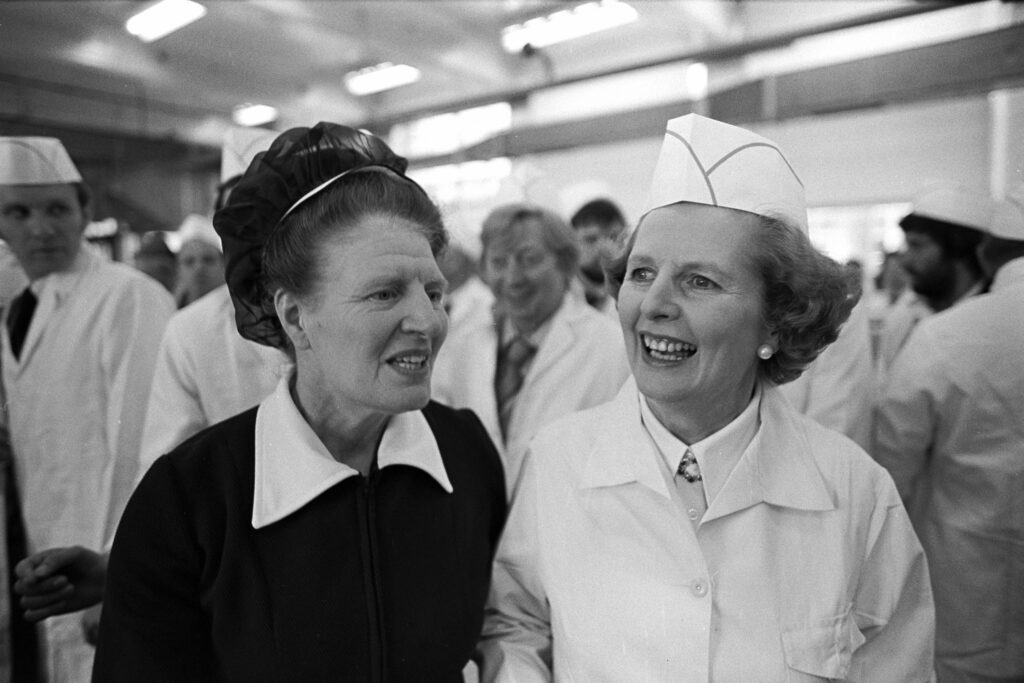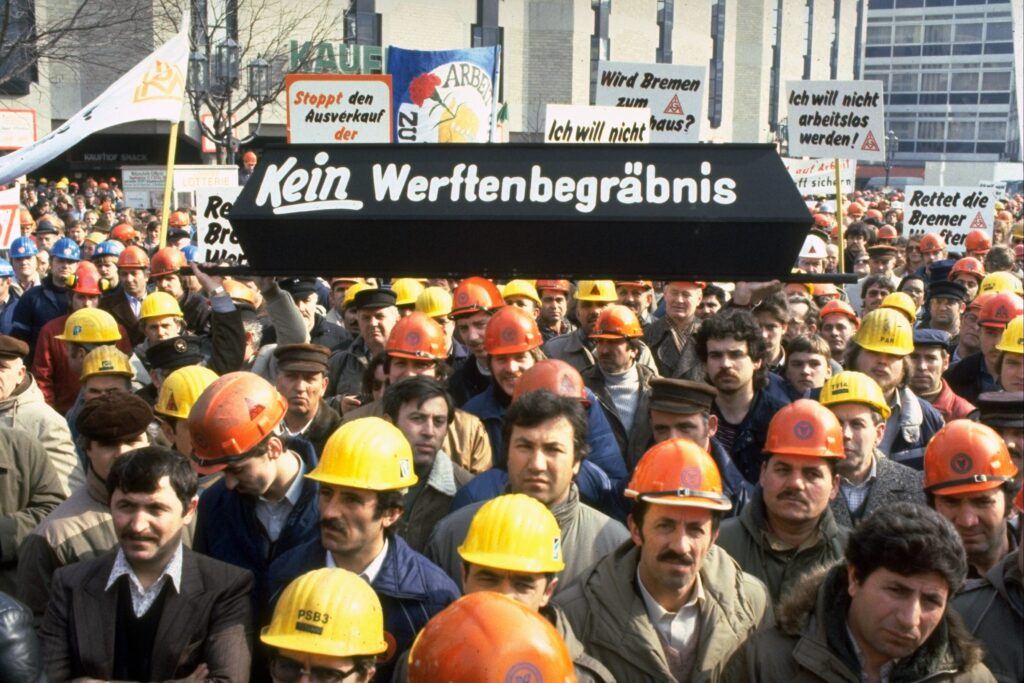Social Democracy After Class?

Can you build social democracy without workers? This question would have been unthinkable a few decades ago. Today, it captures a central challenge that left-of-center parties face around the world.
In the United States, even as the Democratic Party has moved leftward on both social and economic issues, it has less working-class support than ever. In 2020, Joe Biden lost non-college educated voters by 4 points. In a recent New York Times/Siena poll, Harris was trailing by 17 points. The shift in the party’s appeal is evident even among unionized workers. In 1992, Bill Clinton won that demographic by 30 points. In 2020, Biden beat Donald Trump by 19. In the latest forecasts, Harris’s advantage is just 9 points.
Similar shifts are in play across the advanced capitalist world, such as in Germany, where the socialist party Die Linke (the Left Party) went from receiving nearly one third of the vote in the country’s industrial eastern states in 2019 to barely registering as an electoral force there this year. Likewise, even though it is still in power, the Social Democratic Party has tended to fare poorly among workers, who are increasingly drawn to the far-right appeals of the Alternative for Germany: The AfD recently became the biggest group in Thuringia’s state parliament.
For decades, those still committed to a traditional social-democratic program have responded to this crisis of support with some combination of downplaying the problem, looking for substitutes for lost working-class voters, and trying to re-engage their former base by moving rightward on social issues. So far none of those answers has proved satisfactory.
To understand the dealignment of social-democratic parties from workers, we must go back to the origins of these parties. With the emergence of a mass working class in the 19th century, workers began to search for political and economic representation. Since capitalists held political and economic power, workers needed organizations that would pursue their collective interests. Social democratic parties became the political expression of working-class interests in society writ large, and trade unions pursued those interests at the point of production. Never mind whether those organs were effective representatives or whether they were also populated by peasants, artisans and others who could hardly be considered part of the industrial working class; they were inseparable from their core social base.
A left-wing politics rooted around these working-class parties and unions and a set of egalitarian demands were the norm for a century and a half. By no means did this politics represent a unified movement; fractures and splits—between prewar social democracy and anarchism, between postwar social democracy and communism—were common. But any intra-left competition was always over the allegiance of the same people.
In cities like Liverpool or Turin, people lived in neighborhoods and labored in factories densely packed together, forced by capitalism into, if not always bonds of solidarity, then at least commonality. Unsurprisingly, they voted in the main for parties of the broad left. The job of the revolutionary was to convince workers committed to a slow road to socialism to embrace an urgent one.
That’s a laughably easy starting point compared with today, when the working class appears both more fragmented than ever and less drawn to egalitarian politics. William Morris wrote in 1885 that while workers knew they were a class, socialists had to convince them “they ought to be Society,” a force capable of not just existing within an economy but also controlling the future of that economy. Now socialists must scramble to make the case about the class part, too.
How did this happen? Nearly a half-century ago, the British historian Eric Hobsbawm asked whether “the forward march of labor and the labor movement” had been halted, and the French theorist André Gorz declared that the working class was dead as a social agent. Considering the depth of class dealignment today, those prior pronouncements seem both prescient and premature.
The incipient shifts Hobsbawm and Gorz spotted had economic and sociological roots. The gains of postwar social democracy (and those of its stunted American New Deal counterpart) were predicated on economic expansion that gave succor to both workers and capital. When growth slowed in the 1970s, the worker demands that capitalists previously had stomached to keep the peace seemed to them economically untenable. In this new environment, retreating unions and political parties had less to offer workers for their participation.
At the same time, the workers themselves were changing rapidly. Automation and global competition prompted a shift from Fordist employment in industrial sectors to work in service-producing industries. Meanwhile, mass immigration further diversified the working class ethnically. The working class had never been a static entity; rather, it was always a group of people dependent on wages from jobs created by a capitalist system in a perpetual state of flux and recomposition. But the 1970s and ‘80s was a period of particularly rapid transformation, and what really distinguished it was the surprising response of worker-backed parties.
Social democratic formations met the economic capitalist crises of those days by seeking a resolution on the back of their own base. Their ultimate course was conditioned by the basic and universally understood reality that economic growth under capitalism was predicated on capitalists’ belief that they could invest profitability. The working class only existed because of private firms, and workers were locked into both an inexorable class conflict with their employers and a state of dependence on them. Similarly, the redistributive states they had voted into office relied on taxes to sustain themselves. What could be done when capitalists demanded structural change before resuming investment?
At first the stagflation crisis caught the center-left by surprise. Thinking they had abolished the business cycle through state intervention, the old parties of the Marxist Second International forgot a core Marxist tenet: that the contradictions of capitalism, and its tendency toward crisis, couldn’t be resolved within the system. When economic difficulties proved to be more than a transitory effect of the 1973 oil shock, social democrats were left flatfooted. Without the will to pursue alternatives on the left—such as enabling workers to wrest more power over investment through wage-earner funds—they accepted a neoliberal resolution.
The neoliberals had argued that Keynesian capitalism worked to a certain point but had fixed limits. Monetary stimulus beyond those limits would yield inflation without growth, as in the mid-1970s. To unleash growth again meant not spending more money to stimulate demand but dialing back the regulatory welfare state and constricting the bargaining power of unions, which were then seeking inflationary wage hikes to compensate for existing inflation. In short, to jumpstart the economy, the working class would have to accept less. After attempting and failing to borrow its way out of the crisis, social democracy eventually responded to the charge that social democracy itself was at the root of the economic crisis by wholeheartedly agreeing.
In Western Europe, this U-turn was most dramatic in France. François Mitterrand’s 1980s socialist government had come into power with communist backing and radical plans. “You can be a manager of [a] capitalist society or a founder of a socialist society,” Mitterrand said at a 1971 press conference. “As far as we’re concerned, we want to be the second.” However, by the time France’s first leftist government in decades entered office in 1981 France already faced unemployment, economic stagnation, and international headwinds. A resolution was attempted along Keynesian grounds: Mitterrand’s “110 Propositions for France” included a massive public works program, enhanced union rights and codetermination measures, increased minimum wages and pensions, and a reduction of hours in the working week. In 1982, the government put some key industrial groups and almost 40 banks under state control to help maintain employment and speed up economic restructuring.
The result was massive capital flight and deepening economic difficulties. To no avail Mitterrand pled with the business class that he was not a “revolutionary Marxist-Leninist” and that his way was the only way to “end the class struggle.” Ultimately, he won them over not just by halting his program but also by retreating dramatically into the politics of austerity. The lesson was clear for social democrats like Germany’s Gerhard Schröder and Tony Blair’s New Labour: When their time came, they at most sought to marry ex-post redistributive measures to the new economic orthodoxy.
In the United States, where the Democrats’ commitment to workers was always suspect, the transformation had been no less consequential. Jimmy Carter entered the White House in 1977 with a labor-backed program centered around infrastructure spending, full-employment targets, and welfare state expansions. But within a year, alarmed by rising consumer prices, he thought better of these plans and proposed a “lean and tight” budget to control spending.
Inflation continued to rise, reaching double digits in 1979, and so an even more drastic measure was soon taken. Under Paul Volcker, the Federal Reserve contracted the overall money supply by allowing interest rates to soar. Unemployment reached levels not seen since the Great Depression. Carter paired Volker’s shock treatment with reductions in New Deal–era regulatory infrastructure, especially in the financial sector. While the president spoke on TV about America’s moral health, the economic health of the workers who had elected him was failing. A wave of deindustrialization hit the U.S. manufacturing base, spiked the trade deficit, and fueled urban decay. By the time a halting recovery eventually took place in the mid-1980s, Ronald Reagan was in power to take credit.
Like social democracy in Europe, the Democratic Party in the U.S. made its own supporters responsible for getting growth back on track. But what came next was equally damaging. Despite the pain wrought in the late 1970s and ‘80s, Bill Clinton counted on much of the old New Deal coalition to win office in 1992. Once in power, however, he pursued a new bipartisan consensus on free trade and “ending welfare as we know it.” Clinton did little to prevent industrial-job loss, and he embraced suburban professionals and “knowledge workers” as replacements for his party’s lost voters. He found new sources of capitalist support in big tech—among the so-called “Atari Democrats”—and in finance.
The Democrats went from being the party of justice and stability to the party of meritocracy and dynamism. This transformation was clear in Senator Chuck Schumer’s infamous comment on the eve of the 2016 election: “For every blue-collar Democrat we lose in western Pennsylvania, we will pick up two moderate Republicans in the suburbs in Philadelphia, and you can repeat that in Ohio and Illinois and Wisconsin.” Without a New Deal–sized economic vision with a unified working class at the center, Democrats were left to talk about progress solely in the language of representation and civil rights. Such appeals had little tangible to offer to anyone, especially the white men who flocked to Trump in 2016.

Social democracy, and to varying degrees its center-left imitators, first emerged to represent the interests of workers against capital, but it eventually responded to the contradictions of capitalism by choosing the interests of capital over those of workers. Given the asymmetric dependence of labor on capital, this response was rational in an economic sense. But one of its political consequences was the mass departure of workers from parties of the left.
According to Political Cleavages and Social Inequalities, edited by the economists Amory Gethin, Clara Martínez-Toledano and Thomas Piketty, between 1950 and 1959 on average 31 percent more of the working class in Western democracies voted for the left than did voters of other classes. In 2020, that margin was only 8 percent. Importantly, the rich have maintained their traditional allegiance to parties of the right, but the professional classes have shifted in response to the social liberal turn of social democratic parties. In short, parties of labor are becoming parties of the educated.
Some figures on today’s center-left and left glorify the changes underway. Schumer’s remarks were perhaps the most extreme example of this tendency, but it is present even on the contemporary far left. The working class itself is changing, left-wing activists and politicians note, correctly. As more jobs require greater credentials, it has become more educated. It has also become more diverse. Rather than pegging left-of-center politics to a universal subject, they contend, we should see labor as just one important interest group among others, much like “people of color,” environmentalists, the poor, and so on. This broad coalition may look different from the workers’ movement that built classical social democracy, but it will prove just as capable of delivering redistribution.
Although this current is correct to avoid valorizing one particular moment in working-class life, it ignores both the extent to which Fordist stability was the result of hard-won political victories and that the rise of the precariat is itself related to defeats suffered by social democrats and trade unions. Rather than trying to rebuild the left’s social base, these organizers attempt to find a new one, but this time through actors less strategically positioned than workers at the points of production and exchange.
However, a coalition based primarily on ideology is always thinner than one based on both ideology and shared material interests. This fact will create new dilemmas for the center-left parties when they come to power. How will it be possible, for example, to expand welfare states without additional tax revenues from the professionals who now vote against the right for social and cultural reasons?
This recent left-wing approach to politics mirrors the one once embraced by New Labour in Britain. Following Labour’s loss in the 1992 general election, the Fabian Society published “Southern Discomfort,” a pamphlet calling for Labour to reorient toward professionals in the south of England. Its conclusions, which included an emphasis on “opportunity,” “individualism,” and fiscal constraint, were embraced by Tony Blair in his successful 1997 campaign. Blair’s New Labour was at least in part a project to turn Labour from a social democratic party of the working class into “the political wing of the British people”—young, cosmopolitan, and dynamic. The contemporary foes of Blairism seemed to be competing on much the same terrain.
Two other responses to class dealignment are also unsatisfying. One is to deny that it is taking place at all. Michael Podhorzer, a former political director of the AFL-CIO, for example, argues that shifts in voting patterns are mostly the result of divergent regional trends: Workers have moved rightward in states that already were red. Yet as Jared Abbott counters in a thorough review of the data in the U.S., “Working-class voters are indeed more likely to vote Democrat in blue states than in red or purple states, but they are trending away from Democrats in all partisan contexts.”
Another response from social democrats has been to excise liberal values from center-left politics to appeal to what they see as the traditionally conservative values of the working class. In this telling, when parties of the left were more rooted in laboring communities they understood instinctively how to appeal to their constituencies. As they bureaucratized and became more distant from this base and as their voting bloc became more middle class, they sought support by moving too far left on cultural and social issues.
The party of Sahra Wagenknecht (BSW) in Germany is a prominent example of this approach: It offers much of the left’s traditional economic program but tries to outflank the right on issues like immigration, now a major political issue in Germany. The policy of establishment parties in the country has been to reinstate border controls and limit asylum-seekers while encouraging immigration from skilled workers.
That national conversation has coincided with the loss of manufacturing employment. Germany had long avoided the industrial job shedding experienced by other advanced capitalist countries, but employment in the auto sector fell by 6.5 percent last year and 60 percent of automotive suppliers were planning additional cuts in Germany over the next five years. The same is true in other industrial areas. Conglomerates such as ThyssenKrupp and BASF are embarking on cuts. Rapid deindustrialization and the shift to a lower-paid service economy have coincided with the growth of a foreign-born population on benefits. Of the 750,000 working-age Ukrainian refugees residing in Germany, for instance, only one quarter have found work, slightly more than the share receiving unemployment assistance.
This environment has allowed the right-wing AfD to prosper, especially in the deindustrializing east of Germany. BSW, which still identifies as being on the left, has avoided the worst rhetoric on immigration and Wagenknecht herself regularly states her opposition to racism. But in her attempt to win over rightward-moving workers, she has said that “Germany is overwhelmed” and “has no more room” for asylum seekers, and she has lamented the existence of “parallel societies” in unintegrated Muslim neighborhoods. Such narratives make the issue of immigration ever-more salient in German politics—more salient than jobs or the role of the state—and that shift will ultimately benefit the far right.
BSW is concerned, and rightly so, with just how rooted in class leftist parties are today. But its framing of divisions based on national origin within the working class mirrors in a way the left-cum-neoliberal rhetoric that opposes the interests of, say, women and minorities to that of Old White Men. Both descriptions are departures from the traditional socialist foregrounding of the division between capital and labor.
Is there any path forward in response to social democracy’s class dealignment? Other parts of Europe offer a more promising alternative—one that is more orthodox from a socialist perspective and that has also proven itself to be effective electorally. The Workers’ Party of Belgium (PTB-PVDA) was once a sectarian party of the communist left, but it has evolved since 2008 into a mass force shaping its country’s politics. Although it dropped its Maoist baggage long ago, its approach to organizing still seems like it was ripped out of a playbook from a bygone era. The party focuses extensively on base-building in working-class communities; it provides professional social services like primary health care at party action centers; and it has put working-class people at the head of its electoral lists.
This approach has had successes, even beyond the areas of the Workers’ Party greatest support, like Wallonia: In an October election in Antwerp, it secured 20 percent of the vote, second only to the right-wing New Flemish Alliance. Yet while long-term organizing in the mold of the PTB-PVDA has rebuilt the left as an opposition force and helped fuse together socialist ideology with a real social base, it has so far fallen short of securing the power to govern.
This is a concern because lasting political influence can’t be guaranteed without state power. But it’s also worth identifying the shortfalls of pursuing government at all costs.
When conditions aren’t favorable to a leftist program, social democracy can best serve its interests by exerting outside pressure on capitalist-led governments. In fact, a half-century ago, it would have perhaps been better for the left to return to the opposition than to bring about structural adjustments that hurt its base, even if the right-wing variant of austerity risked being even more dislocating. And today it might be better to lose an election with voters committed to your program than to win one thanks to voters who only want to beat back a right-wing social agenda.
Ultimately, the left can’t win enough power to change society without foregrounding bread-and-butter concerns and rooting itself in the constituencies that would benefit the most from the redistribution of resources. That means a commitment to solidarity in many forms, but it also means ultimately recognizing that victory is not possible without the support of people who might have all sorts of contradictory, even reactionary, views. Without this basic realization, the new social democrats will sound like the old communist bureaucrats in Bertolt Brecht’s 1953 poem “Die Lösung” who, after an uprising, propose dissolving the people and electing another.


